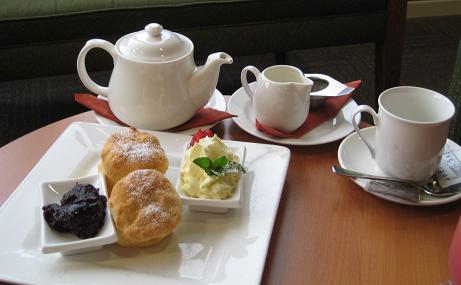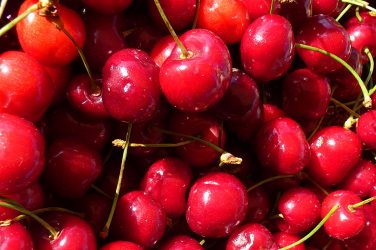“What would the world do without tea?” British Prime Minister Gladstone was a fan of the drink, as are most Europeans today. But tea had to travel many miles to become a central part of European cuisine.
Tea, thé, Tee, ςai… different languages, one drink. Christiane Warmbein investigates our favourite beverage – whether we’re in England, wearing tea dresses and eating cucumber sandwiches, or sipping a scalding glass of tea at a bus stop in Turkey, Europeans love to drink tea. But of course, we didn’t invent it – there was a time when we’d never even heard of it…

The most popular legend about the “invention” of tea is Chinese: for hygienic reasons, Emperor Shen Nung, who lived around 2700 BC, drank only boiled water. One day, some tea leaves flew into his bowl of hot water and flavoured it. After tasting it, he found the beverage to be refreshing and drank it ever after. The various, but similar expressions for tea in most Western languages also originate in China: the Chinese term “cha” or “tu” was one of the few words to be adopted from Chinese by Western languages.
Another story, maybe a little less realistic, was told in Japan: the first Buddhist in Japan, Bodhidharma, fell asleep during mediation around 500 AD. He was so angry with himself that he cut away his eyelids and threw them to the ground. Out of the lids there grew the first tea plants. A bit violent for a drink that is supposed to balance one’s mood, but maybe Bodhidharma became more even-tempered after enjoying tea.
Thank God for tea! What would the world do without tea? I am glad I was not born before tea. – William Gladstone, 19th century British Prime Minister
Today tea is the second most consumed beverage worldwide (after water). It’s an important export product, an economic factor, part of many countries’ national heritage, a medicine, a universal remedy, common contraband and a political instrument. Quite a lot for a type of flavoured hot water, isn’t it?
Tea is a cup of life. – anon.
But tea is more: no other drink offers such a variety and spectrum of taste. However, tea wasn’t always a part of European culture: it travelled a long way from its origins in the Far East, surviving many conflicts and changes in history which ultimately formed the popular drink of modern times.
The history of a success story
The success story of tea and its role in history are as multifaceted as its origins are unclear and legendary. Especially during colonial times, more than one conflict raged over the plant and the beverage. To understand these connections and the progression of tea culture in Europe, a glance at history is useful. The first sources about tea consumption can be found in China around 1000 BC. For a long time, including the first years after its introduction to Europe in the early 17th century, tea was seen as medicine, not as a stimulant or society drink.
Drinking a daily cup of tea will surely starve the apothecary. – Chinese proverb
The first time Europeans ever recognised tea was when Marco Polo mentioned in 1285 that a Chinese minister of finance had been fired because he increased the tea tax. After that, some other famous explorers noted tea, but no one had the idea of importing it. After the foundation of the Dutch East India Company in 1602, the situation for trade in Europe changed remarkably: Dutch traders established a stable overseas trade. Exotic spices like pepper, textiles and tea became trading goods. The first load of green tea arrived in Amsterdam in 1610. 30 years later, tea was a regular element of the loading of each ship, but still in small amounts. Its popularity increased slowly but steadily over the following decades and came to France, England and Germany in the mid-17th century.
The quality of tea in those times was not comparable to modern tea, as it was transported over months in muggy containers on ships. Another option was transport by land, first tried in 1618 to Russia. This tea’s quality was better, but naturally no bigger loads could be transported.
After some time of scepticism, tea culture became a success story from the late 17th century up to the present. Tea shops such as Twining’s were founded, and the beverage became popular in tea salons all over Europe, particularly in England and Friesland. In Britain, a whole new element of culture was invented: for the new meal, the Afternoon Tea, there were tea dresses, tea cakes, tea tableware and accessories.
clipper

After 1700, tea became an increasingly political issue in Europe: from the end of the 17th century, the monopoly on Chinese trade shifted from the Dutch to the British East India Company, and while the British dealt arbitrarily with tea taxes, especially for their colonies, a huge Dutch tea smuggling market developed. The climax of this problem resulted in the Boston Tea Party of 1773, which led ultimately to the American Wars of Independence.
After England lost its monopoly on trade in China in 1834, and trading routes were shortened by the opening of the Suez Canal in 1866, far more tea of better quality could be imported. Because of increasing competition, tea traders let their ships participate in famous races to prove that they had the fastest transportation. The first ship to reach England each year with a load of tea could it for an especially high price. As the demand for faster ships increased, the so-called clipper, a speedy sailboat, was developed. The yearly Great Tea Race between the fastest clippers became a huge social event.
New technical inventions such as the steamboat added significantly to this progress. To avoid further dependence on China, Britain started growing tea in India and Ceylon (Sri Lanka) in the mid of the 19th century.
Since then, tea production and trade to and in Europe has increased constantly.
I got nasty habits – I take tea at three. – Mick Jagger
Tea time across today’s europe
Tea is now enthusiastically consumed all over Europe, but in some countries it has become a national drink. These countries have developed special ceremonies, accessories for, and styles of brewing tea.
In Germany, the Frisian tea culture is well-known. The Frisians consume the comparatively large amount of 2.5 kg of tea per year, whereas the German average is about 250 g. In Friesland, offering a cup of tea to every visitor is an essential part of the famous hospitality of this region. For Frisian tea, the tea is put directly into the prewarmed teapot and covered with hot water. After 3 or 4 minutes, the teapot is infused with more hot water. To prevent the tea from falling into the teacup, a teastrainer is used. Before pouring the tea into the cup, a piece of Kluntje (rock sugar) is put into it and afterwards, a sip of cream is added. Traditionally, Frisian tea is not to be stirred.
On the other coast of the North Sea, tea culture is even more celebrated: the popular British Tea Time isn’t limited to the art of drinking tea. A whole new meal including special pastries, dishes and habits emerged.
Gwendolen: You have filled my tea with lumps of sugar, and though I asked most distinctly for bread and butter, you have given me cake. I am known for the gentleness of my disposition, and the extraordinary sweetness of my nature, but I warn you, Miss Cardew, you may go too far. – Oscar Wilde, The Importance of Being Earnest

The UK is Europe’s second biggest consumer of tea per person with 3.5 kg per year, only topped by Ireland. Black tea is by far the most-consumed tea. As in Friesland, tea leaves are put loosely into a pot which is then filled with boiling water. As the tea becomes stronger and more bitter, more water or milk is added. Tea is usually drunk with milk. The question of what to pour into the cup first – milk or tea? – is dicussed passionately. For a full afternoon tea, the following food will be served: as a “first course”, savoury but light sandwiches, filled with smoked salmon, cucumbers, roastbeef or egg salad are eaten. Afterwards, there are the famous scones, small plain cakes, served traditionally with clotted cream and jam. To finish the meal, sweets like pralines will be handed round. Especially in the British upper class, a complex system of rules about teatime is still in use and handed from one generation to the other. As this is a quite laborious style of enjoying tea, a simpler way, the so-called cream tea with just scones, clotted cream and jam is much more common in everyday life.
Some people would answer that they don’t like tea in itself, that they only drink it in order to be warmed and stimulated, and they need sugar to take the taste away. To those misguided people I would say: try drinking tea without sugar for, say, a fortnight and it is very unlikely that you will ever want to ruin your tea by sweetening it again. – George Orwell, “A nice cup of tea”
The complete opposite can be found in Turkey: Turkish tea is as simple as one can imagine. Served everywhere and very cheap, from the bus stop to the school cafeteria, for Turkish tea, a very strong tea essence is produced by adding just a little boiling water to loose tea. The liquid is then diluted with more hot water. It is served in a glass, with a piece of lump sugar.
Among the younger generation, tea is more popular than Turkish coffee, which was the national drink until the end of the First World War. When Turkey then lost its most important coffee deliverer Yemen, Atatürk urged that people change their habits to tea. In Turkey, tea is consumed very hot, as it is often served when there is just a short break.
No other beverage has had such a difficult but constant success story as tea. Modern inventions like iced tea or green tea ice cream show that this story is not at its end.

Japanese green tea ice cream
You will need: 500 ml cream, 500 ml milk, 175 g sugar, 15 g Japanese Matcha tea, pinch of salt
Stir all the ingredients until the sugar is dissolved, then freeze in your ice cream machine. Put it in your freezer for one hour afterwards and enjoy!
… If you don’t have an ice cream machine, you can put the mixture in a metal bowl in the freezer and take it out every 15 minutes to stir it until it has the right texture.
FlapJack (British cake to eat with tea)
You will need: 225 g soft oat flakes, 150 g butter, 20 g golden sirup, 85 g of brown sugar
Mix oatflakes and sugar. Melt the butter with sirup and pour it onto the oatflakes. Stir the mixture and press it flat onto a greased baking tray (use wet hands). Bake for 15 minutes at 160° C and cut into squares when out of the oven. Let cool down and harden.
Interview with an underground tea-lover
Kerstin Rodgers is the chef at The Underground Restaurant in London – she runs a home restaurant. We asked her for her thoughts on tea.
E&M: What are the first thoughts that come to your mind when you think about tea?
Kerstin Rodgers: It’s refreshing, healing. If you have a shock or an accident, you need a cup of tea.¨
E&M: What meaning does tea have in your professional routine as a gourmet chef? Do you serve or use it often?
K.R.: I sometimes do Underground teas. I’m not really a cake person but I do make them for guests. As far as drinking tea is concerned, one of the problems of being a chef is you are on your feet for long hours and you get dehydrated.
E&M: Is there a special dish you prepare using tea?
K.R.: I’ve made green tea ice cream and also infused various herbal teas in vodka.
E&M: What is your favourite tea?
K.R.: Earl grey.
E&M: What is your favourite time and way to drink tea?
K.R.: With milk, no sugar, all day every day.
E&M: Do you have any tips or secrets about tea which you’d like to share?
K.R.: I like pissy Southern tea. Up north [in the north of England, ed.] they like it strong, so strong you can stand a spoon up in it. I prefer weak tea.
You can find some insights into Kerstin’s wonderful creations on her blog: http://marmitelover.blogspot.com/







